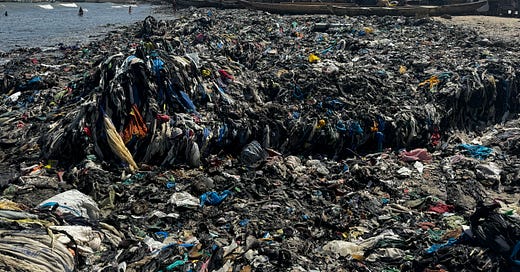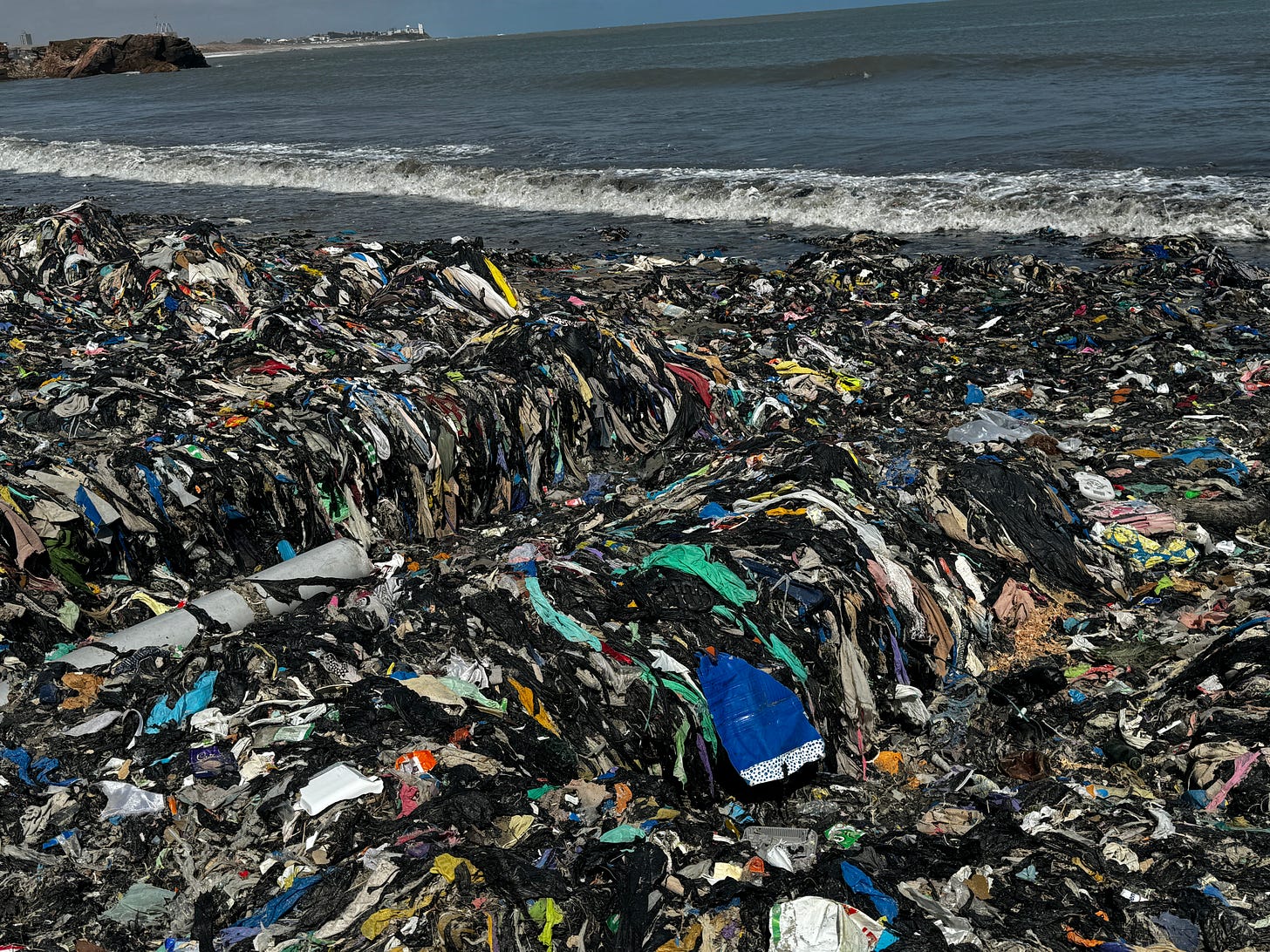The UK's Fast Fashion Waste is Overflowing Accra's Beaches
Our ‘sustainable’ solutions only shift the burden of waste elsewhere.
Sorry for the radio silence on here for the last month or so. Last month I went to Accra, Ghana, on an eye-opening work trip that in many ways debilitated me with thoughts and findings about fashion, textiles and sustainability. I’ve had too many thoughts to know what to do with and it’s taken me some time to process, digest and reflect on what I learnt during this trip.
If you read my last newsletter in September, you’ll know it was about textile waste. Which is a topic I have spent a lot of time researching in the past, particularly focusing on waste colonialism and the secondhand clothing trade. While this is a topic I thought I knew a lot about having researched it for my Masters, this trip unearthed so much about the nuances of the conversation and how the secondhand trade impacts people differently. It also illuminated some ugly truths about the UK, as we are currently the largest exporter of secondhand clothing to Ghana and many stakeholders are involved in keeping this trade profitable for the Global North.
While I don’t want to be repetitive and go on like a broken record, since having some time to pause and reflect, I do want to share some thoughts and learnings from this trip. Coming up to Black Friday, it also seems an important time to reflect on our consumption habits as well as our disposal habits - how do we dispose of our clothes responsibly and do we ever stop to ask the question where do my clothes go once I donate or recycle them?
On my first day of the trip as I walked onto the beach in Accra I was instantly confronted by the reality of where our take-make-waste system ends. It was a sobering reminder of how our linear model thrives off overproduction and overconsumption and starkly highlighted this throwaway culture. The scale of this waste was immense, I’ve never seen anything like it. I’ve heard before that our brains aren’t able to comprehend large numbers and I felt this for the first time the minute I walked onto Jamestown beach and saw discarded textiles as far as the eye could see. The sand below the masses of textiles is no longer visible. To walk across the beach you have to walk on top of the huge tangled masses of clothes - which are dominated by UK fast fashion brands, like Marks & Spencer's and F&F. These heaps of textiles also go beneath the sand and into the sea, littering the seafloor.
15 million garments enter Kantamanto every week (from charity shop donations, take-back schemes and recycling banks) and despite the incredible creativity, ingenuity and amazing upcycling skills of the Kantamanto community (something I will share more about in its own newsletter) the sheer volume of secondhand clothing arriving from the Global North is too much to physically resell due to the poor-quality of clothing received. So approximately 40% of the average clothing bales that enter Kantamanto leave as waste, leaving retailers in vicious debt cycles while most of the waste ends up here on the local beaches. Tangled masses of clothing wash out to sea and onto the beaches in Accra, entangling plastic bags, scrap metal and fishing nets. These mounds of textiles are buried deep into the sand. The Or Foundation are doing weekly community beach cleanups, removing on average 30 tonnes of textiles a month - the clean-up that brands should be doing.
This statistic isn’t saying that 40% arrives to Ghana as waste, it’s saying that 40% leaves as waste because it is unsellable for resellers in Kantamanto Market - because the quality is not good enough. When we consider the quality of what we donate in the UK, I don’t think we ever question if the item is resellable but it’s something we need to start asking ourselves. The problem here lies in the fast fashion business model that enables brands to overproduce cheap low-qualilty garments that aren’t designed to last. The linear model drives the price and quality down in the global race to the bottom. Until fashion brands start designing and manufacturing clothes of better quality then clothes will never be fit for recycling, rewearing or crucially, reselling.
We need to demand fashion brands stop driving overproduction of poor quality cheap clothing and instead produce less whilst designing for longevity. We also need to demand the implementation of effective policies that see brand’s take accountability for their waste by internalising the cost of waste management - otherwise known as Extended-Producer Responsibility. Crucially on this trip it was clear that this secondhand trade is an important livelihood for the 30’000 professionals who work within Kantamanto Market, reusing, repurposing and upcycling the clothes. So it is not a question of banning exports but instead reducing production volumes and ensuring that the clothing being exported is high-quality. As well as ensuring that the resources and funding from EPR flow to the communities mostly impacted by the waste crisis, like Kantamanto, to support dignified jobs.
We need to reflect on the quality of what we donate and challenge the power imbalance of Global North determining the quality of supply while communities, like Kantamanto, have no say in what they receive
Accra should not be forced to clean up Big Fashion’s mess.
Children shouldn’t have to swim in a sea littered with fast fashion.
Fisherman shouldn’t have to catch tentacles of clothing waste that have choked the aquatic life.
The local community shouldn’t have to do weekly beach clean-ups to remove our fast fashion waste.
Retailers in Kantamanato should not be left in vicious debt cycles for a bale that is dominated by unsellable poor-quality clothing.
I’ve been taking some time to reflect on the reality of our overproduction and overconsumption - at an individual level, a societal level and an industry level. Asking myself how I can do better. I know for a fact that in the past I have ‘donated’ something that - on reflection - shouldn’t have been donated, or was put in the wrong recycling bin - and it is highly likely that it ended up in Kantamanto Market, or washed on the beach in Accra. I think many of us have at some point in our life. In the UK and many other Western countries, we regularly treat our waste with an out-of-sight out-of-mind mentality, passing it along for someone else, somewhere else, to deal with. But we can’t continue like this.
Something else I’ve been thinking about over the last few weeks is why is it so difficult for stakeholders to agree, that fundamentally, this is not a just or equitable trade? This trip really opened my eyes to the conflicting interests that exist in the secondhand textile trade - its a hugely profitable model that serves the UK, in terms of profits and in terms of convenience, so it makes sense why certain people want it to remain hidden. Yet it is a hugely exploitative trade that forces the role of waste management to countries in the Global South, without providing the resources or reparations for the true cost of that waste management.
While opinions may differ on the exact statistics of waste exported, there should be no disagreement when it comes to the moral and ethical implications. In the West, secondhand clothing donations, take-back schemes, and recycling programs are often celebrated as hallmarks of sustainability. Yet, when we confront the stark reality of where much of this clothing actually ends up, it's clear there is nothing truly sustainable or ethical about these practices. These images reveal an uncomfortable truth: our ‘sustainable’ solutions only shift the burden of waste elsewhere, masking the real environmental and social costs.
We need the fashion industry to step up and take accountability for the mess that we’re in. While we can all reflect on our own consumption habits and practices, we need legislation to address the root causes of the issue and we need fashion brands to be held accountable for their entire supply chains, including end-of-life.
Through collective action we can challenge the cycle of overproduction, low-quality clothing, and exploitation by demanding better practices from brands and the implementation of policies that enforce accountability and address the root causes of the issue. Each of us has a role to play—from considering the quality and destination of our donations to advocating for a fashion industry that values longevity, transparency, and responsibility. We can push for a future where fashion respects both people and planet.
Thank you for reading.





